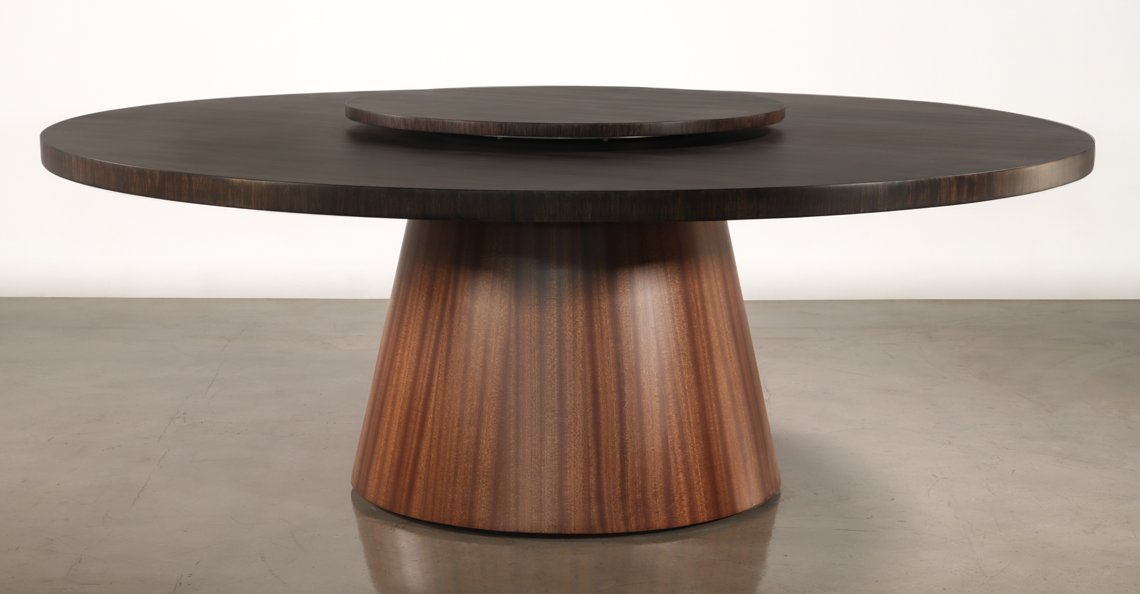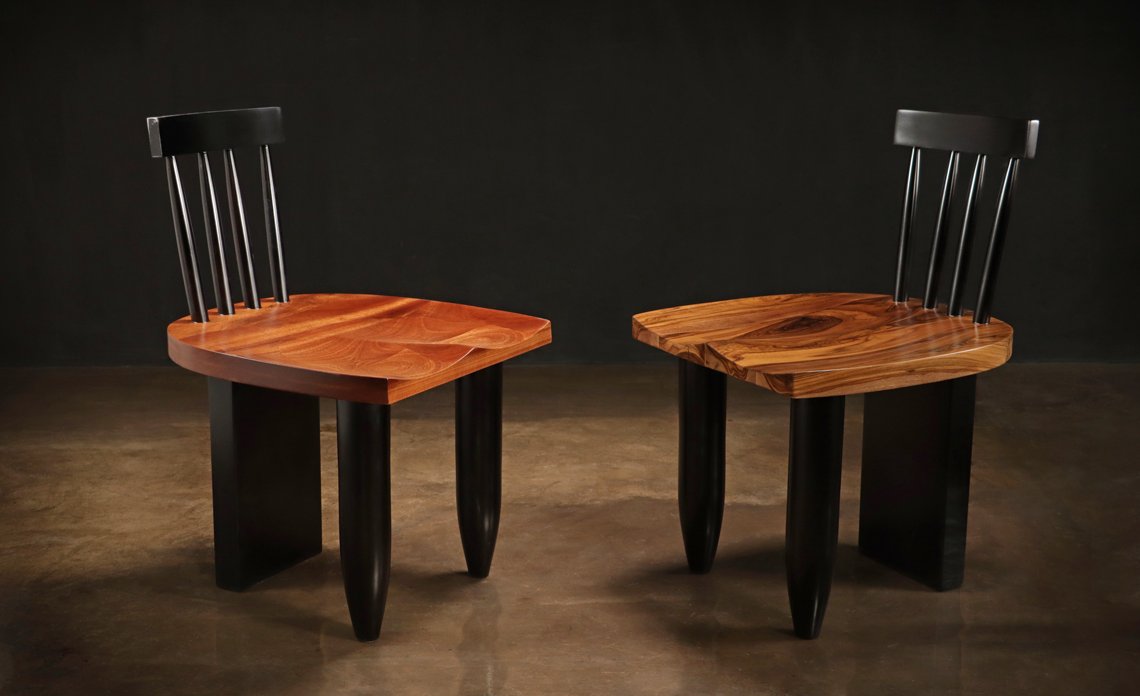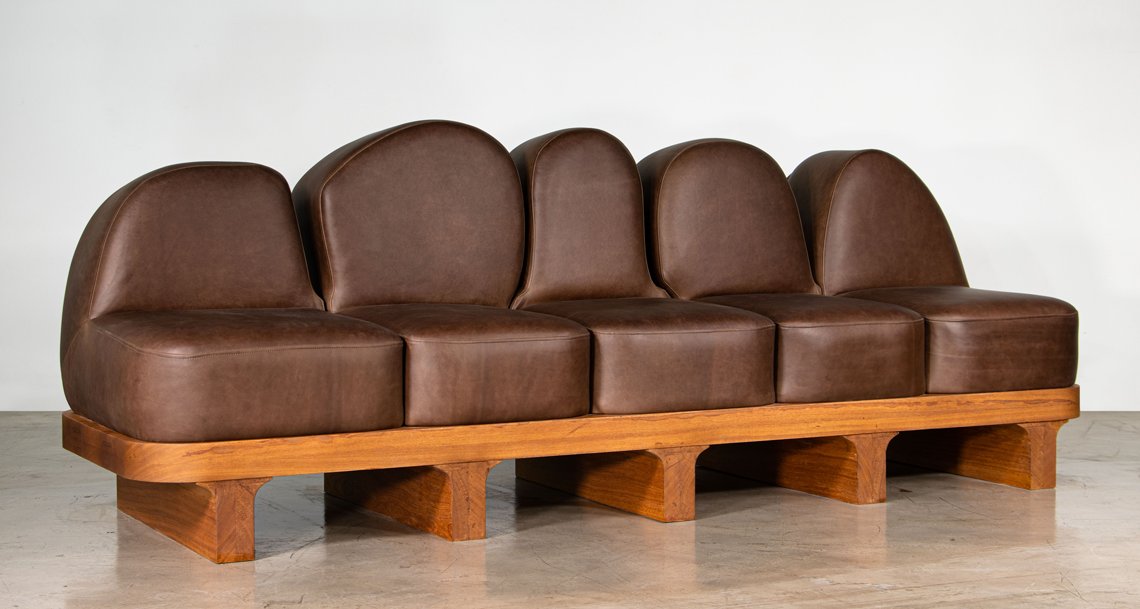N.F.L.-Star-Turned-Designer Michael Bennett Creates Sculptural Furniture Celebrating the Black Home
 |
Cape Mantle for Studio Kër by Costantini. The mantle in the Black family is the first archive a Black person engages with. It often hosts family portraits, Bibles, books, and ephemera that are significant to a family’s understanding and relationship to their traditions and oral histories. The objects placed on the mantle serve as pillars to our histories while the mantle itself holds the foundation for our legacies to be passed forward into the future. Cape Mantle moves the mantle as an object from a silhouette in Black heritage and culture into a promontory vessel of black heritage and culture. |
N.F.L.-Star-Turned-Designer Michael Bennett Creates Sculptural Furniture Celebrating the Black Home
 | |
Designer Michael Bennett, Studio Kër (right) and William Stuart, Costantini Design (left) at ICFF 2024. Costantini Design produces pieces for Studio Kër at the Costantini workshop in Argentina. |
Studio Kër was founded in 2020 with a focus on creating “living spaces that embody the essence of the African diaspora,” says principal and creative director Michael Bennett, who also happens to be a former N.F.L. player (he played 11 seasons) and 2014 Super Bowl Champion with the Seattle Seahawks. He turned to architecture and to design following his retirement “to cultivate a sense of home through design,” he says. Incollect spoke with him about his designs, being a Black designer, and philosophy on life as a journey of continuous exploration and creation.
Photos courtesy Studio Kër
 |
| Gumbo Chair for Studio Kër by Costantini. The chair features a nearly 1" thick fiberglass frame with a smooth seat and textured back/underside. The design emphasizes connection in Black gathering spaces for fellowship, intimacy and celebration. |
Your Gumbo chair and stool are fabulous. Can you tell us how those designs came about?
The Gumbo chair and stool designs emerged from a thoughtful examination of the “monoblock” chair and of traditional African furniture forms. I wanted to create pieces that not only reflect spatial thinking but also capture the essence of gatherings and shared experiences. By merging these elements, I formulated designs that are both functional and symbolic, embodying the richness of African culture and its communal aspects.
-for-Studio-KER-by-Costantini-00.png) |
Gumbo Stool for Studio Kër by Costantini, a companion piece to the Gumbo Chair. The stool is the first seat upon which a child is instructed to rest, sit, learn, or have their hair nourished and cared for. The Gumbo Stool is representative of where we’ve come from and the genius of Black people’s humble traditions. |
“Communion. Rebirth. Craft. Spirit. Experimentation,” that is how you describe what you do. Can you unpack that for us?
My designs often reflect a blend of contemporary and historical elements. Key to that idea, for me, is celebrating the richness of African diasporic culture and its contributions to the global design landscape. I draw inspiration from the vast architectural and cultural dialogues that have taken place over centuries in Africa. Rituals, spirituality, and the concept of inheritance play a significant role in shaping my design sensibilities. These elements connect my work to a larger cultural narrative, providing a profound sense of belonging and continuity.
You mention architecture. It seems to me that your work is very architectural — in addition to being sculptural.
Yes. I have a deep appreciation for pure geometry and am significantly influenced by architectural principles in my work. This approach allows me to explore the interplay between form and function, creating spaces and objects that are both aesthetically pleasing and deeply meaningful to me.
 |  | |
Left: Da Block No. 5 for Studio Kër by Costantini in Red Onyx. Right: Detail, Da Block No. 5 for Studio Kër by Costantini. Each object in the Da Block series is informed by present needs for contemporary surfaces with materiality, color, and finishes connected to African and African Diaspora cultures. | ||
You were a successful N.F.L. player. Does that impact your design work in any way or are they unrelated?
My background is in sports, yes, but I believe this significantly prepared me for a life in design. Playing sports taught me the importance of collaboration, creating systems around a shared ethos, and effective communication with my team. These skills are directly transferable to the design field, where teamwork and a cohesive vision are crucial.
 |
| Mo-Mo's Table for Studio Kër by Costantini in African Sapele. A non-hierarchical dining table for 8–10 persons proposes a communal experience for breaking and sharing proverbial and actual bread. Inspired by the relief work of Akili Ron Anderson’s frieze “Last Supper” 1982 centering a foreshortened circular table, Mo-Mo Table incorporates a turntable representing the return to communal gathering spaces around the shared table. Mo-Mo Table acknowledges the sustenance, oral tradition, and the birthplace of the griot all sustained by the stability and love of Black matriarchs. |
What about creativity — where does that come from?
Being an athlete instilled in me a disciplined work ethic and a natural inclination toward strategic thinking and creative solutions. This combination of experiences has shaped my approach to design, allowing me to navigate challenges and innovate.
 |
| Paw Paw’s Chair in Argentine Rosewood (left) and Sapele (right). |
What does the word Kër mean in your studio title?
Kër means "home" in Wolof — a language and a West African people from northwestern Senegal and Gambia. This name reflects the core of my design philosophy, which revolves around creating spaces that evoke a sense of belonging and comfort. The concept of "home" transcends physical structures, embodying the emotional and cultural connections that make a space truly meaningful. By incorporating this idea into my work, I aim to create designs that resonate with people on a personal level, providing a sense of sanctuary and connection.
-for-Studio-Ker-by-Costantini-00-copy.png) | -for-Studio-KER-by-Costantini-00-copy.png) | |
| Left: Da Block No. 3 for Studio Kër by Costantini in Red Onyx. Right: Da Block No. 1 for Studio Kër by Costantini in Black Zeus stone. The Block series presents primordial forms found throughout Earth’s natural landscape that instructed the first people’s stations for sitting, working, eating and storing. | ||
Tell us about the design process — how do your ideas come about for designs and then transition to objects?
My design process is guided by an ethos: Study, Play, Listen, Speak. This emphasizes the importance of continuous learning and interaction. There are four elements within this. Research: I constantly delve into new information and perspectives, exploring different cultures, histories, and design practices. Iterate: I refine ideas through multiple iterations, ensuring that each design is meticulously crafted. Collaborate: Working together with others enriches the outcomes, bringing diverse perspectives to the table. I have collaborated for example with William Stuart at Costantini, among others, on the production of some of my designs. Make: I turn concepts into tangible reality with hands-on experimentation, sketching, and modeling. This process allows me to transform abstract ideas into concrete designs, ensuring that each piece is thoughtful and purposeful.
 |
| Pews for Studio Kër by Costantini, Angelin wood and leather. Pews are informed by the close proximity of Black bodies gathering in sacred space. Pews, much like the family sofa, reduces the space between one another to set the environment for close connection. |
Your Pews Sofa, shown at the Costantini booth at the ICFF fair in New York recently has a very distinctive shape. What was the inspiration for this design?
The Pews Sofa is part of my “We Gotta Get Back to the Crib” collection from 2023 and is made of upholstered leather and Angelin wood. On one level, the shapely form was inspired by the Black body, but it was also inspired more broadly by my own experiences of being in church. The closeness of people and the sense of a shared human experience inherent in church settings influenced the design, which for me embodies both a sense of physical comfort and emotional resonance.
What materials do you like to work with and why?
I have a profound love of wood. The texture, color, and smell of wood, as well as its natural, living quality, make it an incredibly rewarding material to work with. Wood continues to expand and grow, embodying a sense of life and continuity that aligns perfectly with my design ethos. It allows me to create pieces that feel organic and connected to nature.
Does sustainability factor into your thinking and designs?
Sustainability is a crucial consideration in my design and production processes. I strive to connect with the natural world and animate objects in an environmentally responsible way. This involves selecting materials and methods that minimize environmental impact while ensuring the longevity and durability of the designs.
Your exhibition “Michael Bennett: We Gotta Get Back to the Crib” ran from January 11 – February 10 this year at the artist Theaster Gates’ Rebuild Foundation in Chicago. How did that connection come about?
My connection with Theaster Gates began as an art collector; I have several of his artworks. We met at the Serpentine Pavilion show in London, where we bonded over our shared approach to space-making. His innovative methods and social experiments in agency-creation resonated deeply with my own practice. At the Rebuild Foundation, I showcased design works that challenged the traditional gallery confines and invited viewers to engage with sculpture in everyday life. This approach aligns with Gates' ideology of fostering self-discovery and collaboration.
What's next for you?
I’m working on a new collection of architectural forms in furniture and several pavilions. Additionally, I am designing a home, which involves a lot of exciting and innovative design work. In the future, I aspire to build chapels and museums, exploring new materials and ideas that push the boundaries of my practice. This journey of continuous exploration and creation keeps me motivated and inspired.
 |
Discover More From Studio Kër by Costantini on Incollect
 |



























